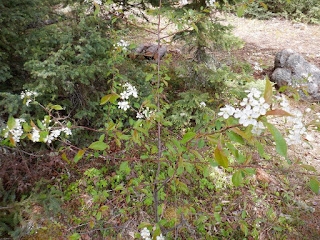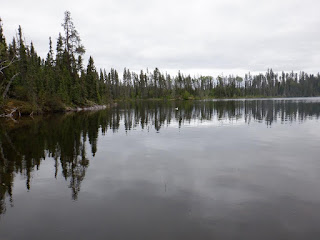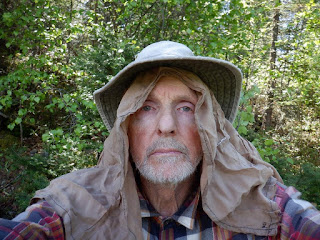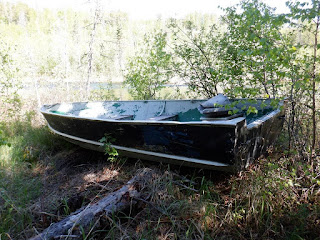June 10 at 4 a.m., weather at camp 3 does not look promising.
June 10 at 10 a.m., cloudy ... but improving?
June 10 lunch in the midst of pretty violets and white Saskatoon flowers - two protein bars, cheese, almonds, a mint, gum, vitamins, 1/4 cinnamon bannock, drinking lake water from the bailer with a LifeStraw® filter.
The trail to the tent site requires 1/2 hour of clearing in order to carry in gear.
Tent site, well sheltered from wind, 130 metres from canoe, which unfortunately proves to have wet ground under the front part of the tent. Note the four overhanging crisscrossed trees directly over the tent, which seem to be stable and safe.
The tent moved to a dry, but exposed spot, on June 11. Note the rocks used to anchor the windward tent pegs pushed into the shallow ground.
June 12, a sunny day and I hang up sleep gear and clothes to dry while I have a glorious but very cold bath.
The Tarp shelter before placing a mat of spruce boughs underneath. Note the butts of the trees I felled to make room for the large Tarp.
The fireplace burns lots of wood in the all day cool 8°C wet weather.
A new fireplace close to the Tarp shelter for a bit more warmth.
A trail cut beside the Tarp shelter to reach the rest of camp. I used this spot for the fireplace and Tarp to avoid the very exposed part of camp where the tent is.
Limbing the felled spruce trees to place the boughs under the Tarp for a nice clean mat.
The downside of moving the fire closer to the Tarp is the extra burn holes that I have to patch with duct tape.
The rain clouds are evident moving toward camp over a period of 40 minutes. It rained June 10-11.
Two loons, just visible across the bay, but very audible with their calls back and forth to each other. Other than a wolf call, there is none other that so typifies the beautiful north country.
A gull keeps me company during my stay here. Sorry to say no fish guts for him.
June 11 supper - fireweed shoots salad, stuffing mix (with butter, Parmesan cheese), a mint, pepperoni, "Birthday Cake" protein bar, hot water.
Basin of hot water for a wash of some important bits.
Just before bedtime, a stocked firewood supply small and large. Under the Tarp shelter out of the rain are birchbark tinder, tools, pots of boiled water.
June 12 at 5:30 a.m., a clear day hopefully. Ready to head out to see if it is possible to canoe down the two km stretch of rapids to reach the Churchill River. If so, besides gear for the day, I load two grub barrels to be pre-portaged. I will walk beside the creek as much as possible to check rapids and portages.
The first set of rapids are "almost" canoeable. Its last stretch though is not (where the wrecked wooden plank boat sits). This boat, decades old predating the aluminum motor boat, was probably swept down from the lake above when not tethered well or beached high enough.
Marsh marigold, reportedly edible if boiled in two changes of water. There are enough more palatable plants instead.
After proceeding all the way down the river and determining it is runnable except for the first rapids, I clear the trail beside it. Having cleared it a few times in recent years, it does not appear to have been used since the last time, being completely blocked in one spot. Blackflies are bothersome so I wear a bandana as a hat scarf when I work. Then I pre-portage the two barrels.
Second rapids.
Third rapids.
Fourth rapids.
Fifth rapids.
**********************
Summary:
Arriving to camp in a heavy downpour. A soggy tent site. Making a warming comfortable shelter while burning lots of wood. A trying move of the tent to a dry location. Two days of rain. Scouting a two km stretch of five rapids. A muddy messy ATV road. Clearing one portage. Pre-portaging my first heavy loads. A cold lake bath. Finally drying out on a gorgeous day. Distance travelled 18 km.
June 10:
Up by 3 a.m. before Wilson, to a cold breakfast. Soon all my gear is sitting outside the cottage. After last minute tidying, I am outside to start carrying gear to the canoe, and it starts to rain. Cannot expect the gods to be kindly just for me all the time. Jeanette did say rain until Thursday. I start carrying items back into the cottage while having two separate conversations ... to go or to stay? Aie! Finally after dithering I decide to leave. Making good time, it is calm for the first four km, then a light wind becoming moderate pushes me from the side towards the windward shore. Soon I canoe down the sheltered side of a long island and stop on the mainland in a burned area to pick two small Ziploc® bags of fireweed shoots, my favourite salad green. As I pass the end of the island, the sidewind forces me towards shore, so I cross to the other side of the lake, not too much of a struggle as the lake is gradually narrowing to the outlet. Hungry well before my usual lunchtime of 11 a.m., I stop at 10:45 to eat at a sheltered somewhat sunny spot. Because it looks like rain, I debate continuing on to a campsite, but my stomach wins. There is a large boulder to sit on in the midst of beautiful purple violets (or are they violet violets?). Right after moving on, at least eight bald eagles, some immature, all take off from the bush near the lunch spot. Perhaps there is carrion there, and I would like to stop to check but the weather does not look promising. Continuing on, only about 1/2 km from my target, rain starts at 11:30 a.m., so I don my rain jacket and pull the tarp canoe cover over my legs. It rains hard and by the time I get the canoe unloaded there are at least 10 litres of water in the canoe. Aie! Jeanette was right about the rain forecast. Distance travelled today is 18 km. I place gear under two tarps to keep dry (or at least not get any wetter on the already wet ground), the tent gear beneath the medium-size tarp (8'x10') and the campfire gear under the large Tarp (10'x14'). The tent site near shore is quite exposed so I clear the trail to a spot 130 metres inland. It takes about 1/2 hour to cut out fallen trees and trim branches off several large trees that I must step over or under. As I erect the tent, I find that the ground under the front third is soggy but it is still raining and I just want to get the tent up. As it is, the inner tent gets damp from falling rain before adding the fly. Aie! Having intended to lay out sleep gear at bedtime, I do it now because I do not want to encourage pools of water to gather under the floor where the packs would lay. The tent floor is already wet in places just from setting up, so after laying out the usual floor tarp, I spread my small tarp (6'x8') folded in half on the lower part of the floor, before opening gear. Because of the wet ground, I do not place any gear in the front vestibule. Now I go to the fireplace site, also 130 metres from the canoe, but in a different direction. Last time I was here a few years ago, I just used the medium tarp as a shelter, but now I fell four spruce and one pine to make room for the large Tarp, which provides a much more comfortable space. Getting the fire going, lighting tinder of shredded birchbark inside a cylinder of bark while sheltering under the Tarp, I put on pots of water to boil. As I work, when it rains heavily, I get under the shelter. I do not wear rain gear while active, because I get very sweaty underneath, plus am likely to tear the outfit. There are two large gulls in my bay. They probably think I will give them something to eat in the form of fish guts. After supper, I fetch and saw some firewood for tomorrow, then wash with hot water, and head to the tent to catch up on my journal. Cool and damp, I am in bed by 8 p.m., zipped up in my sleeping bag right away, to the sound of the falling rain. Everything is damp in such high humidity. Usually in such conditions I would be warmed by the stove in the canvas Tent. Aie!
June 11:
Arising by 4 a.m., it is 6°C, very damp, a misty rain with intermittent heavy showers. Luckily, the tent floor tarp and the extra tarp in the tent kept my gear all dry.
Many experts and tent manufacturers suggest placing a protective tarp UNDER the tent floor, which then causes water to pool between the tarp and the floor and you end up with a wet floor, like sleeping in a bathtub. I place mine on top of the floor. It also catches all debris from boots when entering tent; when packing up, the floor tarp is simply folded in on itself and emptied outside. I have NEVER had a wet floor ... well ... except once when the plastic pee bottle leaked because of a crack.
A belted kingfisher "krrrrrrrs" nearby along the shore, a warbler sings cheerily despite the rain, a bald eagle screeches overhead, two gray jays murmur quietly nearby, a raven croaks overhead, Canada geese honk as they fly above, mergansers quack as they skitter away surprised by my camp, a pileated woodpecker laughs madly across the bay, two loons have a lively conversation. Two gulls visit repeatedly, but are quiet and probably not pleased that I make no contribution to their meals. From my journal: "Cool and very damp. Aie! Cottage would have been nice yesterday. C'est la vie. Should have taken Jeanette's advice, although travelling today does not look promising either. Don't know if she meant rain inclusive of today Thursday or rain until then." It rains hard again just as I reach the Tarp shelter. When the rain slows, I get the fire going with birchbark tinder and lots of dryish mossy spruce and balsam fir branches, then to combat the rain, I add large dry logs cut last evening. Next, I get water on, the large pot of raw water to boil, the medium pot to heat for breakfast drink. (When storing a pot of water that has not been boiled yet, I place a small twig on the lid as a reminder.) Now I mix cinnamon bannock and set the Dutch oven on coals raked out of the fireplace to bake, with more coals on the lid. If conditions are good, the bake time is 10 minutes. While breakfast is in the oven, and then while it rests 10 minutes before eating, I saw off the tops of the four spruce trees felled yesterday. Luckily they toppled close enough to the ground, the uppermost one just above my height, but reachable with the bow saw. I limb them, piling all as a floor under the Tarp shelter, much better now, drier, cleaner, leveller. There are several dead dry spruce poles that I have to fell in order to reach the tops, but they make good firewood. After eating half my breakfast, I create a second fireplace closer to the Tarp shelter. Once it burns well with some large wood, I can feel the warmth under the Tarp while I finish breakfast, write my journal and do a crossword and sudoku. From my journal: "Wish I could hang up sleep gear. Cut lots of big wood to stoke the fire throughout the day. Fetch a big dry spruce stump, sorry I'm taking a red squirrel's roost for eating spruce seeds. Visited by a very large spider which crawls up the pot and then across my boot." Besides the above chores, there are more to do: photos to take, garbage to clean up (always present on waters accessible from the road), sharpen axe, erect clothesline (which I hope to use tomorrow). After supper, my biggest chore of the day, or at least the most worrisome, is shifting the tent to a drier spot. It has not rained in the afternoon, but still looks threatening. After debating, I decide to make the move. Planning to drag the tent 130 metres to the new spot, it is not the safest thing to do as the tent could get damaged. It would be safer to take the tent down, but then the inner tent will get damper and if it rains will get even wetter. I must first make a clearer path by using the axe to knock off all protruding obstacles that would catch and rip the tent (limbs on side trees, protruding sticks and loose branches in and on the ground). First I carry all the gear from inside the tent to the new location, covering with the medium tarp in case it rains. Removing all the tent pegs and the two short poles in the vestibules, and tying up the anchor ropes and bungee cords, I start dragging the tent. I have to keep going to the rear of the tent to move the back two poles around and over obstructions. With two people it would be safe and quick. There are two major obstacles (visible in the photos above), a large tree near the tent to go over and another to go under. The ridge of the fly, a new one!, scrapes under the overhanging tree. Aie! Then I peg and tie out the tent, and move and lay out the gear inside. I am happy, so much better, not soggy like the old spot. This location is very exposed to wind, but dry on the level rock face. In this case dry trumps sheltered. The move is finished just before bedtime, and it did not rain ... yeah! A bonus, the tent is almost dry already ... double yeah!
June 12:
Last night was a cool breezy 7°C, but I slept well, zipped up in my down sleeping bag, the hood closed. Up by 5 a.m., it is cool but not as damp as the previous tent site thank goodness. From my journal: "Put on heavy fleece sweater. Thought I'd warm up enough by the fire ... NOT. Much better! Usual routine after leaving tent. Rinse pee can with bailer water, then invert on a bed of moss to drain. Carry Rubber Pack, chair, canteen, bailer to fireplace site. Thirsty last night before bed related to the tent move so drank water from canteen which has to be topped up with potable water from a water pot. Two gray jays murmur outside tent while I'm getting dressed; very welcome wake up music. Canada geese honking overhead. Pileated woodpecker hammering away nearby. In mature bush like this there are lots of dead or dying trees to interest woodpeckers. Get out Writing Bag for thermometer to check temperature. Get fire going teepee fashion for faster burn. Put water on to heat. Rinse eyes and nose with potable (boiled) water. Get out Lunch Bag. Take photo of my bay to show difference day by day. Start SPOT at 5:35 a.m. (and record time in calendar). Eat breakfast - hot water, mint, peanut butter, two protein bars, seeds. Done breakfast by 6:30 a.m. Going to canoe the 1-1/2 km to the lake exit to see if safe to run the rapids (4? or is it 5?). Will take the two grub barrels to pre-portage if possible. Will take Rubber Pack (including the empty aluminum travel pot), Personal Pack, gun, medium tarp, barrel harness, Tool Bag, PFD, sponge, rag (to wipe canoe hull), bailer. Hope to hang sleep gear in sun when I return. Will duct tape Tarp burn holes before I leave. Time to floss and brush teeth, bathroom, pack Rubber Pack and go to canoe." The Rubber Pack contains my daily required gear including in-use maps; the Personal Pack has survival gear, satellite phone, used and upcoming maps; the Tool Bag holds bow saw, axe, pruner, spare saw blades, small spare saw (removed for the day are the pee bottle, shovel, axe file). Always need to be prepared for rain or to stay away overnight.
When I reach the start of the creek rapids, I tie fast the canoe and leave all gear inside until the route is checked. Taking only my two belt bags, I walk down the valley along the creek as close as possible, moving directly to the creek often to check the rapids. The first rapids are not runnable because of rocks and shallow water at the bottom. All others prove canoeable, mostly on the right-hand side, except rapids two and three which divide and have to go left. As required, I walk sometimes along the river and others on the ATV "road", going in towards the river to check often enough to make sure I can scan the entire rapids, taking photos both down and upstream. I hesitate to call the ATV "road" a trail. About half the distance of the ATV road is very muddy (as seen in the photos below), laying in water or water running down and eroding the steep hills. It is very very rough, getting more eroded all the time, must be a very bumpy ATV ride. The road is used to ferry aluminum motor boats and other large items between the road-connected lake and the Churchill River. Where the ruts are worn from ATV traffic, they are full of water. Interestingly and providing some hint of the potential natural redress of the issues, one place where the ATV road was previously closer to the creek and directly on the original portage trail, it is gradually drying up and regrowing grass and plants. The ATV road travels over much of the original walking trail except for the first upper portage. After making my way to the outlet of the creek and the last rapids, I walk back directly on the 2-1/2 km ATV road, having to step to the side in many places to avoid mud and water. It would not be a pleasant experience to have to portage heavy gear in such spots. There is lots of garbage at both ends and bits scattered along the trail, mostly pop cans and bottles. At the ends though it is oil cans, gas cans, food cans, tarps. Aie! There are two abandoned wrecked ATV quads, one midway and one at the lower end. The ATV in use is at the upper end and is getting very banged up. There are several in-use motorboats at each end.
After determining that the creek is canoeable except for the first rapids, I unload the canoe at the upper end. Then I clear the first portage in about one hour, finishing at noon, the trail being mostly okay except for one blocked spot with snow-downed trees. It appears I was the last to clear it in 2017 when I also ran the same four rapids.
Water levels were high then as they are now or it would not be doable without wading or portaging. Hopefully I do not have to wade. This trip I think the water is even higher, but that is good as I also have a fuller canoe (four months of grub instead of two). While working, I drink a half canteen water. Very hungry, sweaty and a bit weary, I eat lunch - LifeStraw water, 1/4 cinnamon bannock, two mints, two protein bars, almonds, cheese, gum. Blackflies are bothersome, kept mostly at bay by my hat scarf; moving my head to keep the scarf in motion keeps the bugs manageable. Wanting to get back to camp, I do not bother making a fire to shoo them away. Carrying the two barrels (33 kg each) to the lower end of the 420 metre trail, this is the first portage of the season ... and with heavy loads.
Back at camp by 2:30 p.m., it is a beautiful day, mostly clear and sunny, 19°C. The campsite faces the afternoon sun, so I hang all my sleepgear on the clothesline. Time for a much needed bath, I string all my sweaty clothes, plus my rinsed handkerchief and bandana. Trying a different type of ear plug, they pop out as soon as my head is in the lake water, just like the set last year. Ear plugs were recommended by my physician to help prevent vertigo which first occurred in very cold water in 2018. So I make sure to not stay under the water any longer than necessary and to tip my head and massage my ears to drain water right away. From my journal: "Oh man, that feels good! Very cold! Brrrrrrrr! Sunshine and light breeze on the open rock face soon dries me and my clothes." As always at this time of year, I spot many of the same small blue butterflies and medium-size yellow ones; to every thing a season. Twice a kingfisher dives into the lake to catch a fish right in front of me. Planning to bake a cinnamon bannock in the morning, I do not pre-pack. It has been a long day; weary, to bed by 8 p.m. Running through my mind is my plan for the trip down the rapids tomorrow: will wear wading gear; hopefully I can lay all the barrels down in the canoe to lower the centre of gravity as much as possible; wish for another nice day.
Sadly the ancient Cree portage route, except for most of the first trail, is now ruined where the ATV "road" has eroded it. My son Steven, when he was a youngster, and I, used the original portage trails around the rapids 35 years ago, pre-ATV. If I could not have run the majority of the rapids this trip, I would have taken an alternate portage route through three nearby lakes. (Note, the two ATVs and the boat are derelict equipment.)



































































































